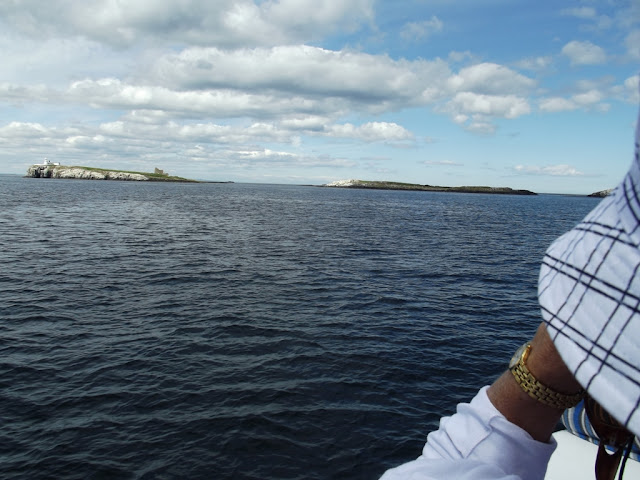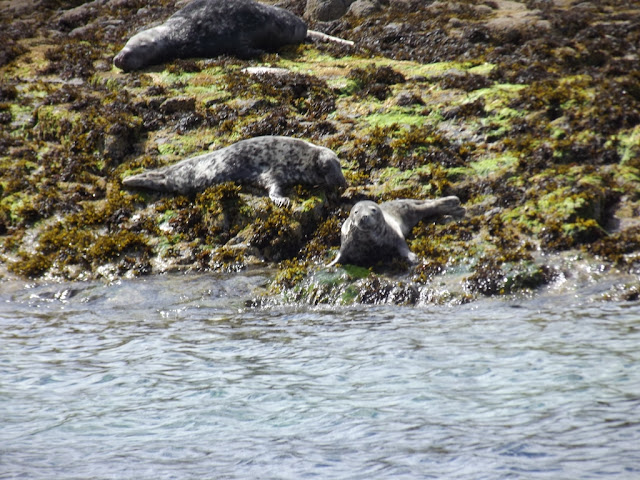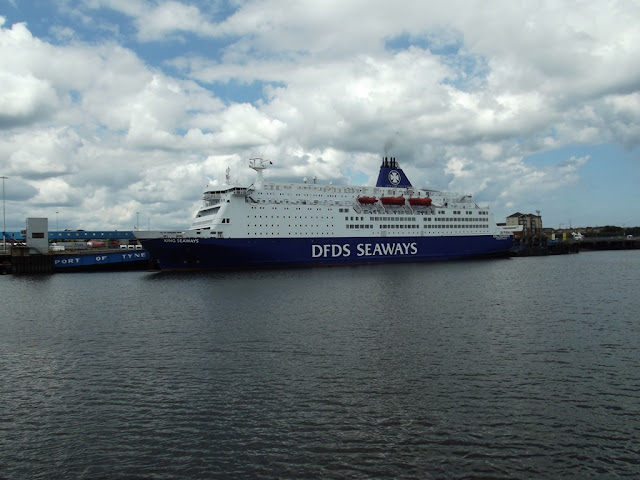On a fine morning we arose early as we were leaving Davina and Roy's place and heading off to Edinburgh in Scotland for the next leg of our adventure.
We had a great time with Davina and her husband Roy who kindly gave up their time to show us around the Whitley Bay and Newcastle areas and beyond.
We hit the road at 9.30am as we had a big day planned. On the trip, Lyn's main aim was for us to see some Puffins so we headed up the coast to Seahouses (I kid you not), a small town which has a nice harbour where boats go out to the Farne Islands to see all the wildlife on and around the Islands.
We arrived at about 11.30am and found an all day park for £3.50 in the park and pay car park. We then went off to find a cruise operator to take us out to the Farne Islands which, in the breeding season, are where the Puffins and various other sea birds breed.
We soon found a kiosk where we organised a 90 minute cruise around the Islands for £11 each. We managed to get on the noon cruise which worked out beautifully, giving us just enough time to have a coffee.
When we went down to get on the boat there were quite a few people waiting to board.
We got under way and we were soon circling one of the many islands just offshore where there were hundreds of seabirds nesting. Nearby were breeding colonies of Arctic and common terns on the inner Farne Islands and Atlantic Puffin, Shag and Razorbill on Staple Island, a bit further out. Unfortunately the Puffins had just about finished their breeding so there weren't many on the rocks but we were able to see several hundred in the water and flying around the islands.
Lyn was surprised how small they were. They are rather plump birds with short wings which they have to flap really hard to keep airborne. That isn't a problem for them because they are accomplished swimmers and divers when they are in the water.
Also around the Islands were dozens of seals frolicking in the water and lazing on the exposed rocks and islands.
We both thoroughly enjoyed the trip as the weather was perfect, the sea was calm and there were plenty of animals and birds to see.
After the trip we headed just a few kilometres north to visit Bamburgh Castle, a spectacular castle built c. 420 on a basalt outcrop overlooking the sea.
After a rest we went to see if we could cross the causeway to the Holy Island of Lindisfarne just a bit further up the coast.
The island measures 2¼ miles from east to west and 1½ miles from north to south, and comprises approximately 1,000 acres at high tide. The island is located about 2 miles from the mainland. It is close to the border with Scotland and is accessible, most times, at low-tide by using a bitumen road crossing sand and mud flats which are covered with water at high tides. Access depends on the tides which despite the warnings many people ignore and end up stranded with their vehicle full of water.
Fortunately the tides were on our side and we were able to visit the island and get back before the tide came in.
We then headed off and crossed the Scottish border and for many miles thereafter there were lots of speed cameras. As we got closer to Edinburgh the roads, which were 4 to 6 lane dual carriageways, became choked with traffic which at times was at a standstill. This continued onto the Edinburgh bypass until we reached a junction were 99% of the traffic exited the dual carriageway onto a motorway heading towards Glasgow and fortunately we did not so the road was suddenly almost empty.
We arrived at our hotel at about 5.30pm which was in a quiet area with a view of woods and the Firth of Forth out of our second floor window. There was no vehicular traffic noise at all so we thought great until we found that an almost continuous stream of aircraft flew straight up the Firth coming right past our hotel when coming in to to land at Edinburgh airport.
At this point the forecast rain began and it looks like continuing for a couple of days. We'll see.
We had a great time with Davina and her husband Roy who kindly gave up their time to show us around the Whitley Bay and Newcastle areas and beyond.
We hit the road at 9.30am as we had a big day planned. On the trip, Lyn's main aim was for us to see some Puffins so we headed up the coast to Seahouses (I kid you not), a small town which has a nice harbour where boats go out to the Farne Islands to see all the wildlife on and around the Islands.
We arrived at about 11.30am and found an all day park for £3.50 in the park and pay car park. We then went off to find a cruise operator to take us out to the Farne Islands which, in the breeding season, are where the Puffins and various other sea birds breed.
We soon found a kiosk where we organised a 90 minute cruise around the Islands for £11 each. We managed to get on the noon cruise which worked out beautifully, giving us just enough time to have a coffee.
When we went down to get on the boat there were quite a few people waiting to board.
We got under way and we were soon circling one of the many islands just offshore where there were hundreds of seabirds nesting. Nearby were breeding colonies of Arctic and common terns on the inner Farne Islands and Atlantic Puffin, Shag and Razorbill on Staple Island, a bit further out. Unfortunately the Puffins had just about finished their breeding so there weren't many on the rocks but we were able to see several hundred in the water and flying around the islands.
Lyn was surprised how small they were. They are rather plump birds with short wings which they have to flap really hard to keep airborne. That isn't a problem for them because they are accomplished swimmers and divers when they are in the water.
Also around the Islands were dozens of seals frolicking in the water and lazing on the exposed rocks and islands.
We both thoroughly enjoyed the trip as the weather was perfect, the sea was calm and there were plenty of animals and birds to see.
After the trip we headed just a few kilometres north to visit Bamburgh Castle, a spectacular castle built c. 420 on a basalt outcrop overlooking the sea.
After a rest we went to see if we could cross the causeway to the Holy Island of Lindisfarne just a bit further up the coast.
The island measures 2¼ miles from east to west and 1½ miles from north to south, and comprises approximately 1,000 acres at high tide. The island is located about 2 miles from the mainland. It is close to the border with Scotland and is accessible, most times, at low-tide by using a bitumen road crossing sand and mud flats which are covered with water at high tides. Access depends on the tides which despite the warnings many people ignore and end up stranded with their vehicle full of water.
Fortunately the tides were on our side and we were able to visit the island and get back before the tide came in.
We then headed off and crossed the Scottish border and for many miles thereafter there were lots of speed cameras. As we got closer to Edinburgh the roads, which were 4 to 6 lane dual carriageways, became choked with traffic which at times was at a standstill. This continued onto the Edinburgh bypass until we reached a junction were 99% of the traffic exited the dual carriageway onto a motorway heading towards Glasgow and fortunately we did not so the road was suddenly almost empty.
We arrived at our hotel at about 5.30pm which was in a quiet area with a view of woods and the Firth of Forth out of our second floor window. There was no vehicular traffic noise at all so we thought great until we found that an almost continuous stream of aircraft flew straight up the Firth coming right past our hotel when coming in to to land at Edinburgh airport.
At this point the forecast rain began and it looks like continuing for a couple of days. We'll see.
Bamburgh Castle
Our boat
London to Edinburgh express
Scottish border
Seahouses Lifeboat

























































